Cham is a member of the Chamic branch of the Malayo-Polynesian language family. It is spoken by about 318,900 people, mainly in Cambodia, and also in Vietnam, Thailand and Laos. There are two main varieties of Cham - Western Cham, spoken in Cambodia, Vietnam, Thailand and Laos, and Eastern Cham, spoken in Vietnam. The two varieties have much in common, but are not mutually intelligible. Speakers of the former tend to use the Arabic alphabet, while some speakers of the latter still use the Cham alphabet. During the French colonial period, both Cham communities had to use the Latin alphabet.
In 2009 there were 204,000 speakers of Western Cham in Cambodia, particularly in Kampong Cham and Tbong Khmum provinces. There were about 25,000 Western Cham speakers in Vietnam in 2007, mainly in An Giang and Tay Ninh provinces and in Ho Chi Minh city. There are about 4,000 speakers of Western Cham in Thailand, mainly in Krung Thep province, and also in Bangkok. There are also about 340 Western Cham speakers in Savannahkhet province of Laos.
In 2007 there were about 72,900 speakers of Eastern Cham in Vietnam, mainly in Binh Thuan, Dong Nai and Ninh Thuan provinces, and in Ho Chi Minh city.
The Cham alphabet developed from India's early Brahmi script. The earliest known inscriptions in the Cham alphabet date from the first millennium AD.
Vowels and Diphthongs
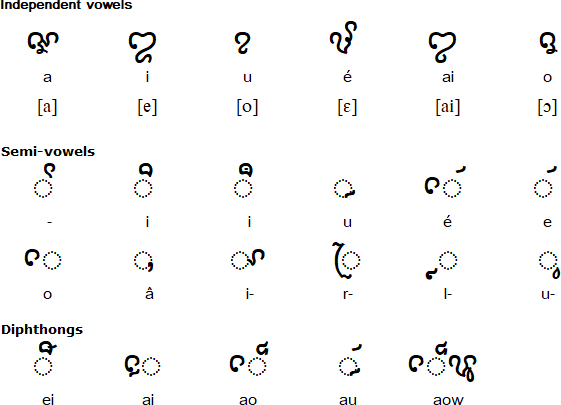
Consonants
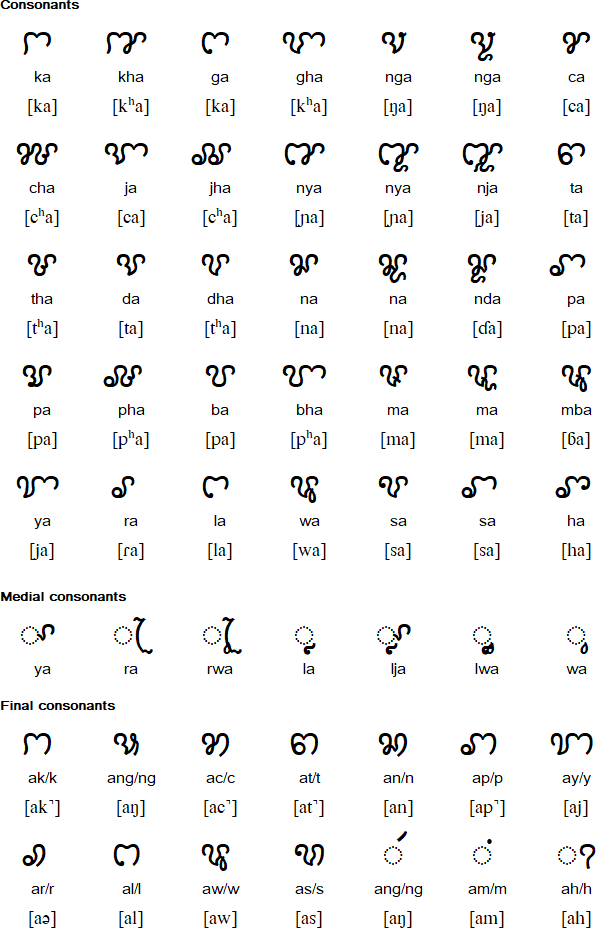
Numerals

Vowel and vowel diacritics
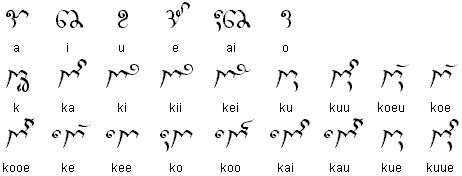
Consonants
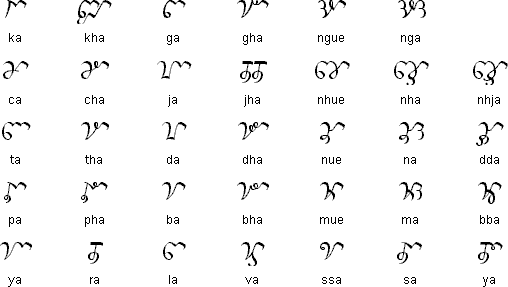
Numerals

The Cham fonts used on this page were created by Jason Glavy
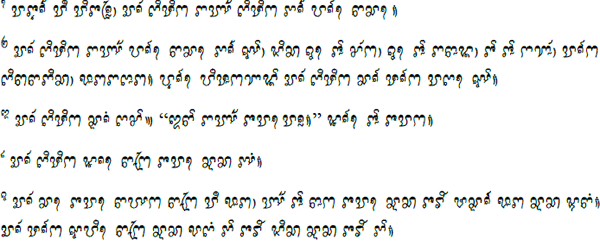
Source: Language Museum
Genesis 1: 1-5. Source: Bible Gateway
Information about Cham | Numbers
Information about Cham
https://en.wikipedia.org/wiki/Cham_language
https://en.wikipedia.org/wiki/Cham_script
https://www.ethnologue.com/language/cja
https://www.ethnologue.com/language/cjm/22
https://www.everyculture.com/wc/Tajikistan-to-Zimbabwe/Cham.html
https://kauthara.org/cham-lesson
Acehnese, Cham, Chru, Haroi, Jarai, Rade
Ahom, Aima, Arleng, Badagu, Badlit, Basahan, Balinese, Balti-A, Balti-B, Batak, Baybayin, Bengali, Bhaiksuki, Bhujimol, Bilang-bilang, Bima, Blackfoot, Brahmi, Buhid, Burmese, Carrier, Chakma, Cham, Cree, Dehong Dai, Devanagari, Dham Lipi, Dhankari / Sirmauri, Ditema, Dives Akuru, Dogra, Ethiopic, Evēla Akuru, Fox, Fraser, Gond, Goykanadi, Grantha, Gujarati, Gunjala Gondi, Gupta, Gurmukhi, Halbi Lipi, Hanifi, Hanuno'o, Hočąk, Ibalnan, Incung, Inuktitut, Jaunsari Takri, Javanese, Kaithi, Kadamba, Kamarupi, Kannada, Kawi, Kharosthi, Khema, Khe Prih, Khmer, Khojki, Khom Thai, Khudabadi, Kirat Rai, Kōchi, Kodava Lipi, Komering, Kulitan, Kurukh Banna, Lai Tay (Tai Yo), Lampung, Lanna, Lao, Leke, Lepcha, Limbu, Lontara/Makasar, Lota Ende, Magar Akkha, Mahajani, Malayalam, Meitei (Modern), Manpuri (Old), Marchen, Meetei Yelhou Mayek, Meroïtic, Masarm Gondi, Modi, Mon, Mongolian Horizontal Square Script, Multani, Nandinagari, Newa, New Tai Lue, Ojibwe, Odia, Ogan, Pahawh Hmong, Pallava, Phags-pa, Purva Licchavi, Qiang / Rma, Ranjana, Rejang (Kaganga), Sasak, Savara, Satera Jontal, Shan, Sharda, Sheek Bakrii Saphaloo, Siddham, Sinhala, Sorang Sompeng, Sourashtra, Soyombo, Sukhothai, Sundanese, Syloti Nagri, Tagbanwa, Tai Noi, Takri, Tamil, Tanchangya (Ka-Pat), Tani, Thaana, Telugu, Thai, Thirke, Tibetan, Tigalari, Tikamuli, Tocharian, Tolong Siki, Vatteluttu, Warang Citi
Page last modified: 16.03.23
[top]
You can support this site by Buying Me A Coffee, and if you like what you see on this page, you can use the buttons below to share it with people you know.

If you like this site and find it useful, you can support it by making a donation via PayPal or Patreon, or by contributing in other ways. Omniglot is how I make my living.
Note: all links on this site to Amazon.com, Amazon.co.uk
and Amazon.fr
are affiliate links. This means I earn a commission if you click on any of them and buy something. So by clicking on these links you can help to support this site.
[top]